And the Glockenspiel Goes
Round and Round
by Bob Brooke
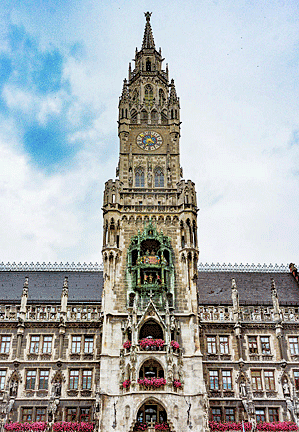 At
11 A.M. daily, crowds of onlookers pack the Marienplatz in Munich to
view a unique performance from what amounts to a city clock in the Neues
Rathaus, the New Town Hall—the Glockenspiel. This timepiece has been
entertaining visitors and locals alike for over a century. But what most
who are watching don’t realize is that there’s a group of dedicated 10
workers who operate the Glockenspiel by hand. At
11 A.M. daily, crowds of onlookers pack the Marienplatz in Munich to
view a unique performance from what amounts to a city clock in the Neues
Rathaus, the New Town Hall—the Glockenspiel. This timepiece has been
entertaining visitors and locals alike for over a century. But what most
who are watching don’t realize is that there’s a group of dedicated 10
workers who operate the Glockenspiel by hand.
The City of Munich added
this chiming clock to the tower of its New Town Hall in 1907, upon
completion of the building. The Glockenspiel daily re-enacts two stories
from the 16th century. It consists of 43 bells and 32 life-sized
figures. The top half of the Glockenspiel tells the story of the
marriage of the local Duke Wilhelm V, who also founded the world famous
Hofbräuhaus, to Renata of Lorraine. In honor of the happy couple there’s
a joust with life-sized knights on horseback representing Bavaria in
white and blue and Lothringen in red and white. Naturally, the Bavarian
knight wins every time.
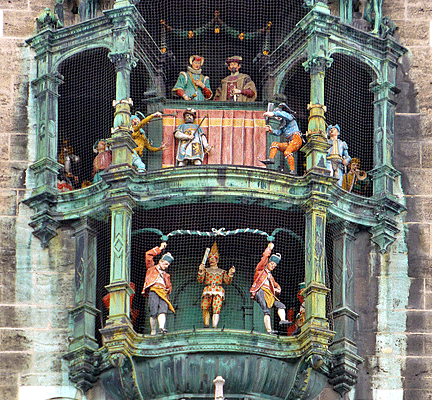 Upon
completion of the top story, the bottom half and second story—the
Schäfflertanz or the coopers' dance—begins. According to myth, 1517
brought a severe plague to Munich. Legend says that the coopers danced
through the streets to give Munich’s residents the all-clear that the
plague was over. The coopers remained loyal to the duke, and their dance
came to symbolize perseverance and loyalty to authority through
difficult times. By tradition, a group of dancers, dressed in authentic
costumes, perform the dance in many locations in Munich every seven
years. Though this dance supposedly originated in the early 18th
century, it’s current form only dates from 1871. Upon
completion of the top story, the bottom half and second story—the
Schäfflertanz or the coopers' dance—begins. According to myth, 1517
brought a severe plague to Munich. Legend says that the coopers danced
through the streets to give Munich’s residents the all-clear that the
plague was over. The coopers remained loyal to the duke, and their dance
came to symbolize perseverance and loyalty to authority through
difficult times. By tradition, a group of dancers, dressed in authentic
costumes, perform the dance in many locations in Munich every seven
years. Though this dance supposedly originated in the early 18th
century, it’s current form only dates from 1871.
The show lasts between 12 and 15 minutes, depending on which tune plays
that day on the Glockenspiel’s 43 bells. At the end of the show, a small
golden rooster appears at the top of the Glockenspiel and chirps quietly
three times, marking the end of the spectacle.
The Workings of the Glockenspiel
 The
control center for this giant entertainment machine occupies a small
space on the fifth floor of the tower. Externally, it resembles a
display case. Under the glass are the shift levers with which workers
operate the Glockenspiel. The Hahn or rooster, which crows at the
end of the Glockenspiel and the Hanswurst, an ensemble member of
the Schäffler, are also switched on by hand. The
control center for this giant entertainment machine occupies a small
space on the fifth floor of the tower. Externally, it resembles a
display case. Under the glass are the shift levers with which workers
operate the Glockenspiel. The Hahn or rooster, which crows at the
end of the Glockenspiel and the Hanswurst, an ensemble member of
the Schäffler, are also switched on by hand.
The bells on the top-floor create the music that accompanies the scenes.
When a worker turns on the main switch, a purple cylinder, which is
partially covered with small metal pins, begins to rotate. The
arrangements of the pins produces the programmed melodies. Each pin
triggers a bell strike via a switch relay. The principle is the same as
a barrel organ, which is manually driven by a crank.
Overall, the Glockenspiel has six cylinders with a total of 22 different
melodies, predominantly from folk songs dating back to the early 20th
century, in its repertoire. The four pieces of music on cylinder 6,
however, are only played during Advent.
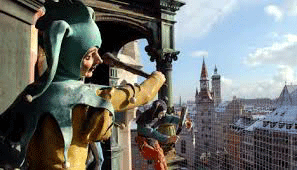 To
ring the 43 bells in the Bellfry, a staffer manually manipulates one of
the 44 well-oiled musical mechanisms—there are 44 of them for 43 bells,
one is a substitute. Here, by means of chains and a gear mechanism, the
operator sets the bells in motion by pulling on a device which ensures
that the clapper in each bell makes it ring. To
ring the 43 bells in the Bellfry, a staffer manually manipulates one of
the 44 well-oiled musical mechanisms—there are 44 of them for 43 bells,
one is a substitute. Here, by means of chains and a gear mechanism, the
operator sets the bells in motion by pulling on a device which ensures
that the clapper in each bell makes it ring.
The Characters
As the show begins, a standard bearer from the entourage of the Bavarian
Herzog Duke Wilhelm V, recognizable by the white-blue diamonds and the
Bavarian lion on the flag, appears. Wilhelm V and his wife, Renata of
Lothringen (Lorraine), are already waiting for the courtiers to march in
and for the knight tournament to begin.
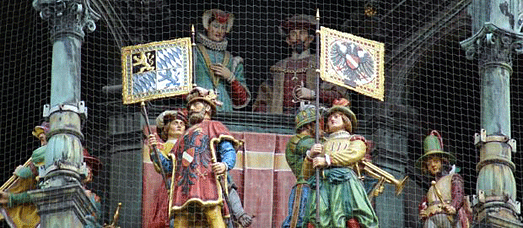
This was one of the most expensive and downright decadent weddings of
the Middle Ages. The Austrian archdukes arrived in a train of over 1500
horses and more than 600 oxen were carved and cooked up for the
revelers. On the day of the nuptials, no less than 3,500 riders escorted
the bride from the nearby town of Dachau.
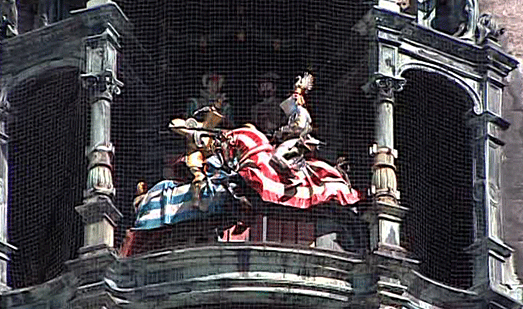
The highlight was the Kröndlstechen, or crown joust, which took
place right on Marienplatz and is now a big part of the Glockenspiel
show. This medieval joust plays out Glockenspiel's top level. Caspar
Nothaft von Wernberg zu Alhaming of Bavaria was declared the overall
winner. He’d reportedly injured several fingers on his left hand, but
not before unhorsing four riders.

The tournament, on the occasion of the two-week-long wedding
celebrations of Wilhelm and Renata, actually did take place on the
Marienplatz in the spring of 1568. The 2.10-meter-high rider figure of
the Lothringer with his red and white helmet is the eternal loser. In
the second round, he falls off his horse and must be manually picked up
by a staffer at the end of the show.
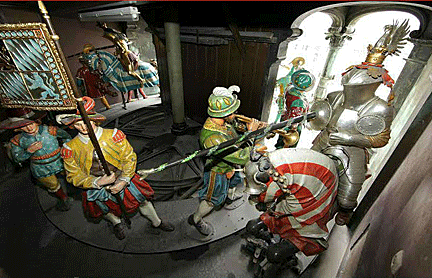
When the bride and groom left the Frauenkirche (Our Lady’s
Church) after the wedding, snow is said to have covered the ground.
Today, the figures of the Glockenspiel defy wind and weather for 364
days of the year. Only on Good Friday is the Glockenspiel silent.
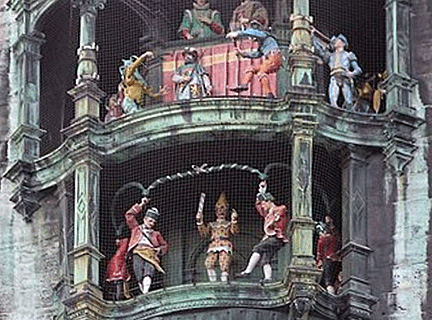 On
the lower level the red-coated city’s coopers, or barrel makers, who are
members of the Fassmacher or barrel-maker guild, perform their
ritualistic dance known as the Schäfflertanz. On
the lower level the red-coated city’s coopers, or barrel makers, who are
members of the Fassmacher or barrel-maker guild, perform their
ritualistic dance known as the Schäfflertanz.
There’s also a mini-show at 9 P.M. each evening, when two figures appear
from the bays below the clock face. On one side there’s the Angel of
Peace blessing the Münchner Kindl, the Munich’s child-monk
mascot. On the other side a night watchman appears, sounding the city
curfew on his horn, accompanied by the strains of Johannes Brahms’
Wiegenlied or “Lullaby.”
At the end of each performance, applause wells up from the crowd on
Marienplatz, much like that from the passengers in an airliner when the
pilot makes a great landing.
The electro-mechanical Glockenspiel works almost exactly as it did when
it was installed. Today, solar power provides the electric energy.
Considering that it has been in operation for over a century, it runs
very well, but it does need attentive care and maintenance: Its
individual parts have to be ground and lubricated, contacts polished,
screws need to be retightened, little wheels, gears and stops regularly
replaced.
<
More Special Features
Next Article > |
